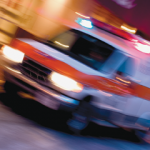By the Fire Dog, as interpreted by Patrick Reitz, Idyllwild Fire Chief
Did you feel it? Maybe you heard it? There was a 4.7 earthquake that shook the Hill around 10 a.m. Monday morning.
What you may not know is that there was a smaller one at 2.7 about 20 minutes earlier; a 3.0 in the La Quinta area about the same time, and during the next three hours four more “aftershocks” that varied between 2.5 and 2.8 occurred.
Or maybe you felt the 3.5 that hit Loma Linda on March 5th? (http://earthquake.usgs.gov/earthquakes/map/)
It is always amazing to me that no matter how divided the neighbors, both in a local and on a global sense, when faced with a disaster or threat of a disaster, neighbors and strangers alike, will lend a hand.
While a 4.7 earthquake is not the big one, think of the media coverage we have seen covering big disasters — earthquakes, tornadoes or tsunamis. We have seen the images of the devastation in the paper and on TV.
Note the throngs of people that are right in there — digging through the rubble and helping to move the debris in an effort to rescue the victims. As with any major disaster, the emergency services are overwhelmed and they cannot possibly be expected to operate without the help of “John Q. Public” pitching in and helping where they can.
The resources begin to mobilize almost immediately from around the world, as well as from their local region — but it takes time. During that time of mobilizing resources, those right there in the thick of it are the neighbors helping neighbors — they are the rescuers. They are the heroes.
With any emergency, it takes time for the emergency services to mobilize, no matter where they are. And as you move out of the more urbanized areas, you move further and further away from short response times.
If you live where you are served by a volunteer department, as is approximately 70-80% of the U.S., you need to add to those response times. It takes time for the volunteer to stop what he or she may be doing at that particular time, change clothes if necessary, and respond to the station to get whatever vehicle may be needed to respond to that particular emergency.
It is important to remember that volunteers come from all walks of life, and may have to stop working or do something with the kids to be able to respond to a call for help. Factor in the time of day — were they sleeping, or what is the traffic like? What is the emergency they are responding to — is it something that affects a lot of people such as a traffic accident on a busy section of road, or is it something that will be noticed by a lot of people, such as a fire?
Maybe the incident directly affects or involves the emergency workers. How many of those in the last major disaster do you remember hearing
about had their own homes and businesses destroyed and their family members injured, missing, or killed?
It is important to keep these things in mind before the emergency occurs — we always say we will get prepared, or think we are prepared, but few of us really are prepared.
Get trained! First Aid and CPR training is a must, at the very least. Once you get trained, stay trained. If you are not recertifying at least every 2 years, you are probably more than a little rusty and need to get refreshed and retrained.
Consider attending additional training for the types of disasters that could strike your area — wildfire, flood, earthquake, tornado, hurricane, blizzards, heat waves, locusts. Remember those personal disasters as well — fire, car accidents, home accidents, water and sewage problems. This applies to those around you as well.
Get Prepared! Equip your vehicle, your home, and your person with what you may need for each situation that you may encounter — food, water, tools, etc. Don’t forget some of the often over-looked essentials such as toilet paper, medication, food and water for the family pets.
Check your supplies on a regular basis — check the expiration dates. Be sure the supplies are still there and undamaged in good working order. And make sure that you as well as those around you know where everything is and how to use it appropriately.
Finally, get to know your neighbor. What special needs do they have? What special skills do they have? What supplies and equipment do they have? Who are they?
Remember there is more to being a good neighbor than just living next to someone.
Coming up, we will discuss more specifics such as water supply, food, power, fuel, and even pets.
In the meantime, some additional resources to consider and where you can get involved! include the Mountain Disaster Preparedness, or MDP, Civilian Emergency Response Team or CERT, American Red Cross (//www.redcross.org/) and the Federal Emergency Management Agency (www.fema.gov/).
As always, I welcome your comments and questions. Please feel free to contact me care of the Town Crier or [email protected].
I’ve got some smells to sniff …
Remember to play it safe in all that you do!










